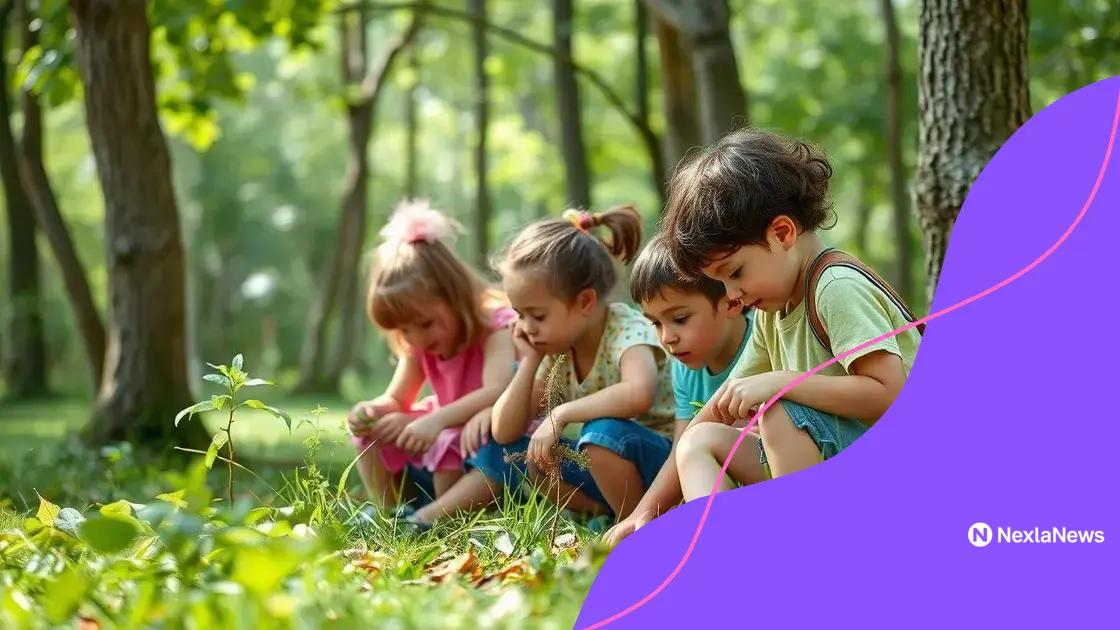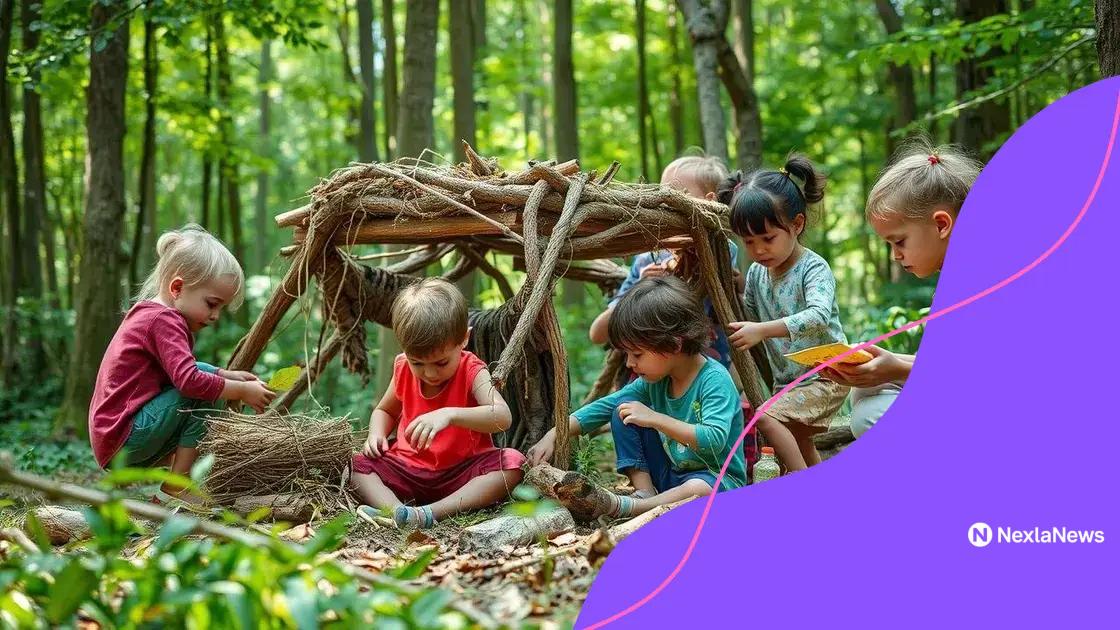Benefits of outdoor learning for children’s growth

Outdoor learning fosters children’s development by enhancing their physical health, social skills, creativity, and emotional well-being through interactive experiences in nature.
Did you know that benefits of outdoor learning extend beyond traditional classroom walls? Engaging with nature can remarkably enhance children’s learning and growth experiences. Let’s dive into how these outdoor interactions can shape their development.
Understanding outdoor learning
Understanding outdoor learning is essential for recognizing its benefits. It involves engaging students in nature to enhance their educational experience. By stepping outside the classroom, children interact with their environment, which fosters curiosity and joy in learning.
What is Outdoor Learning?
Outdoor learning can take various forms, including lessons in gardens, parks, or any natural setting. This approach emphasizes experiential learning, allowing children to explore, ask questions, and make discoveries. Through hands-on activities, they can connect theoretical concepts with real-world applications.
Benefits of Outdoor Learning
- Improved focus: Nature has a calming effect that can enhance concentration.
- Physical health: Outdoor activities encourage exercise and promote a healthier lifestyle.
- Social skills: Group activities foster teamwork and communication among peers.
These benefits highlight the importance of integrating outdoor learning into educational practices. When children are exposed to different environments, they develop a greater appreciation for nature and its significance.
Furthermore, outdoor learning stimulates creativity. Children are encouraged to think outside the box while engaging in imaginative play. This creativity can translate into other areas of their work, enhancing overall academic performance.
Another essential aspect of outdoor learning is its interdisciplinary nature. Subjects like science, art, and even mathematics can be taught in an outdoor setting, making lessons more engaging. For example, students can measure the height of trees or collect and analyze soil samples.
Incorporating these experiences into lessons not only reinforces knowledge but also creates lasting memories for students. Such positive associations with learning pave the way for lifelong curiosity and engagement.
The impact of nature on child development
The impact of nature on child development is profound and multifaceted. Natural environments provide unique experiences that contribute to various aspects of a child’s growth, from physical health to emotional well-being. Exposure to nature encourages exploration, which leads to increased curiosity and learning.
Physical Health Benefits
Being outdoors promotes physical activity, essential for children as they grow. When children engage in outdoor play, they increase their strength, coordination, and endurance. This active play reduces the risk of obesity and associated health issues.
Emotional and Social Development
Interaction with nature can significantly affect children’s emotional states. Studies show that time spent outdoors reduces stress and anxiety levels. Nature also fosters social skills; children learn to communicate and share during group activities in natural settings.
- Reduced stress: Natural environments can calm the mind.
- Teamwork skills: Playing outside often requires collaboration.
- Empathy development: Observing nature can enhance empathy for living things.
Furthermore, natural surroundings stimulate imaginative play. Children create stories and scenarios based on their environment, enhancing their cognitive abilities. This creative thinking is not only fun but also plays a crucial role in problem-solving skills.
Nature also provides sensory experiences, from different textures and colors to sounds and smells. These varied stimuli are essential for sensory development and can improve focus and attention in children.
Overall, the benefits of nature in a child’s life are numerous. By integrating outdoor activities into education and daily routines, caregivers and educators can support children’s overall development in a balanced, engaging, and healthy way.
Promoting creativity through outdoor activities

Promoting creativity through outdoor activities offers children unique opportunities to express themselves. When children play outside, their imaginations flourish in ways that can be more challenging in a traditional classroom setting. Nature acts as a canvas where they can explore and create.
Benefits of Creative Outdoor Play
Outdoor play encourages children to think outside the box. They can interact with their environment, using natural elements like sticks, stones, and leaves to craft imaginative scenarios. This hands-on interaction helps develop their problem-solving skills and boosts their confidence.
Types of Creative Outdoor Activities
- Nature art: Gathering materials from nature to create art pieces fosters creativity.
- Imaginative role-play: Acting out stories or roles with friends adds depth to their playtime.
- Building forts: Using sticks and leaves helps develop spatial awareness.
These activities not only stimulate creativity but also encourage teamwork and collaboration. When children engage in group activities, they learn to share ideas and work together towards a common goal. This collaboration enhances their social skills and teaches them the values of cooperation and compromise.
Furthermore, outdoor activities allow children to connect with nature, which supports their emotional well-being. They experience the sensory stimulation of fresh air, changing weather, and the diverse sounds of the outdoors. This connection to nature helps ground them, promoting mental clarity and focus.
Moreover, promoting creativity outdoors cultivates resilience. Children learn to face challenges, adapt to new situations, and think critically, all essential skills for their development.
Social skills fostered in outdoor settings
Social skills fostered in outdoor settings are vital for children’s development. When children play outside, they interact with peers in ways that are often different from structured classroom environments. This informal setting allows them to practice communication, teamwork, and conflict resolution.
Collaboration and Teamwork
Outdoor play typically involves group activities, such as sports, games, or imaginative play. These experiences help children learn the importance of working together. They learn to share resources, listen to each other, and coordinate actions to achieve common goals.
Communication Skills
Playing outside also enhances children’s verbal and non-verbal communication skills. As they engage in discussions or negotiate in games, they practice expressing their thoughts clearly. They also learn to read body language, which is crucial for effective interaction.
- Listening: Active play requires listening to instructions from peers.
- Expressing emotions: Sharing feelings about play builds emotional intelligence.
- Resolving conflicts: Navigating disagreements helps develop critical problem-solving skills.
Additionally, outdoor environments provide a unique space for children to explore their identities. They can express themselves freely, which can lead to improved self-esteem. As they interact with others, they learn to understand different perspectives and cultural backgrounds, promoting empathy and respect.
The camaraderie developed during outdoor play can enhance friendships. These social bonds are crucial for emotional support as children navigate their formative years. Moreover, strong friendships can lead to positive behaviors and academic success in school.
By encouraging outdoor play, caregivers can create opportunities for children to develop these essential social skills naturally and effectively. The benefits of learning in nature extend beyond immediate play and can have lasting effects on children’s interactions for years to come.
Creating effective outdoor learning programs
Creating effective outdoor learning programs requires careful planning and a clear understanding of the educational goals. Programs should aim to integrate nature with a curriculum that enhances students’ experiences outside the classroom. This approach can foster a love for learning and provide unique opportunities for personal and academic growth.
Key Components of Outdoor Learning Programs
Successful outdoor learning programs often include several critical components that promote engagement and learning. First, programs should provide a variety of activities that suit different learning styles. This variety keeps students interested and allows them to explore their interests.
Collaboration with Educators
Collaboration among educators is essential. Teachers should work together to design lessons that connect outdoor experiences with classroom objectives. This teamwork can ensure that outdoor activities reinforce key concepts and skills from the curriculum.
- Curriculum alignment: Outdoor activities should match the subjects being taught.
- Student involvement: Engage students in planning activities to boost ownership.
- Assessment methods: Develop ways to evaluate learning outcomes from outdoor experiences.
Moreover, safety should be a primary focus in the planning process. Creating a safe environment allows students to explore without fear of injury or harm. This focus encourages adventurous learning and gives children the confidence to try new things in nature.
In addition to safety, accessibility is vital. Programs should accommodate all students, including those with different abilities. Access to natural spaces should be easy so every child can participate in outdoor learning, regardless of physical limitations.
Finally, ongoing evaluation of the program’s effectiveness is necessary. Gathering feedback from students and educators will help refine outdoor learning experiences and ensure they continue to meet educational goals.
FAQ – Frequently Asked Questions about Outdoor Learning
What are the main benefits of outdoor learning?
Outdoor learning enhances children’s physical health, social skills, creativity, and emotional well-being by allowing them to explore and engage with nature.
How can outdoor programs foster teamwork among children?
Outdoor programs encourage collaborative games and activities, which require children to communicate, share responsibilities, and work together towards common goals.
What should be prioritized when creating outdoor learning programs?
Safety and accessibility should be prioritized to ensure all children can participate actively. Additionally, aligning activities with educational objectives enhances learning outcomes.
How can parents support outdoor learning experiences?
Parents can encourage outdoor play, participate in nature activities with their children, and advocate for school programs that integrate outdoor learning into the curriculum.
